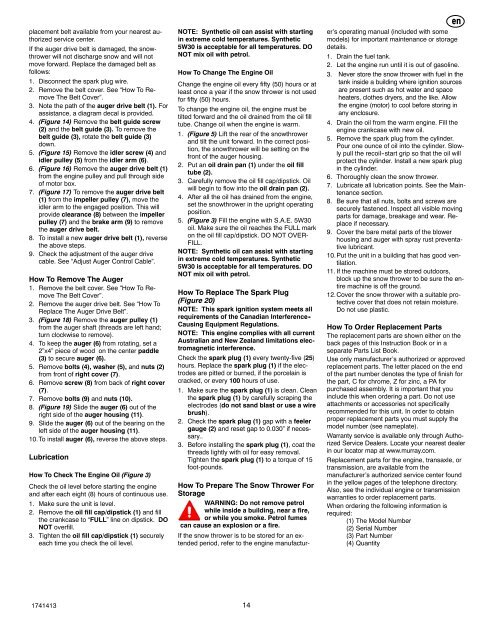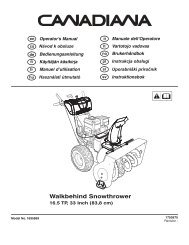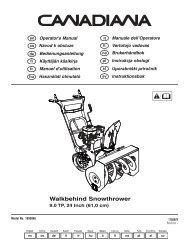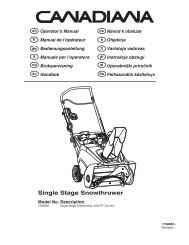Instruction Book - Snowthrower Model 6210701x54NA ... - Canadiana
Instruction Book - Snowthrower Model 6210701x54NA ... - Canadiana
Instruction Book - Snowthrower Model 6210701x54NA ... - Canadiana
Create successful ePaper yourself
Turn your PDF publications into a flip-book with our unique Google optimized e-Paper software.
placement belt available from your nearest authorized<br />
service center.<br />
If the auger drive belt is damaged, the snowthrower<br />
will not discharge snow and will not<br />
move forward. Replace the damaged belt as<br />
follows:<br />
1. Disconnect the spark plug wire.<br />
2. Remove the belt cover. See “How To Remove<br />
The Belt Cover”.<br />
3. Note the path of the auger drive belt (1). For<br />
assistance, a diagram decal is provided.<br />
4. (Figure 14) Remove the belt guide screw<br />
(2) and the belt guide (3). To remove the<br />
belt guide (3), rotate the belt guide (3)<br />
down.<br />
5. (Figure 15) Remove the idler screw (4) and<br />
idler pulley (5) from the idler arm (6).<br />
6. (Figure 16) Remove the auger drive belt (1)<br />
from the engine pulley and pull through side<br />
of motor box.<br />
7. (Figure 17) To remove the auger drive belt<br />
(1) from the impeller pulley (7), move the<br />
idler arm to the engaged position. This will<br />
provide clearance (8) between the impeller<br />
pulley (7) and the brake arm (9) to remove<br />
the auger drive belt.<br />
8. To install a new auger drive belt (1), reverse<br />
the above steps.<br />
9. Check the adjustment of the auger drive<br />
cable. See “Adjust Auger Control Cable”.<br />
How To Remove The Auger<br />
1. Remove the belt cover. See “How To Remove<br />
The Belt Cover”.<br />
2. Remove the auger drive belt. See “How To<br />
Replace The Auger Drive Belt”.<br />
3. (Figure 18) Remove the auger pulley (1)<br />
from the auger shaft (threads are left hand;<br />
turn clockwise to remove).<br />
4. To keep the auger (6) from rotating, set a<br />
2”x4” piece of wood on the center paddle<br />
(3) to secure auger (6).<br />
5. Remove bolts (4), washer (5), and nuts (2)<br />
from front of right cover (7).<br />
6. Remove screw (8) from back of right cover<br />
(7).<br />
7. Remove bolts (9) and nuts (10).<br />
8. (Figure 19) Slide the auger (6) out of the<br />
right side of the auger housing (11).<br />
9. Slide the auger (6) out of the bearing on the<br />
left side of the auger housing (11).<br />
10.To install auger (6), reverse the above steps.<br />
Lubrication<br />
How To Check The Engine Oil (Figure 3)<br />
Check the oil level before starting the engine<br />
and after each eight (8) hours of continuous use.<br />
1. Make sure the unit is level.<br />
2. Remove the oil fill cap/dipstick (1) and fill<br />
the crankcase to “FULL” line on dipstick. DO<br />
NOT overfill.<br />
3. Tighten the oil fill cap/dipstick (1) securely<br />
each time you check the oil level.<br />
NOTE: Synthetic oil can assist with starting<br />
in extreme cold temperatures. Synthetic<br />
5W30 is acceptable for all temperatures. DO<br />
NOT mix oil with petrol.<br />
How To Change The Engine Oil<br />
Change the engine oil every fifty (50) hours or at<br />
least once a year if the snow thrower is not used<br />
for fifty (50) hours.<br />
To change the engine oil, the engine must be<br />
tilted forward and the oil drained from the oil fill<br />
tube. Change oil when the engine is warm.<br />
1. (Figure 5) Lift the rear of the snowthrower<br />
and tilt the unit forward. In the correct position,<br />
the snowthrower will be setting on the<br />
front of the auger housing.<br />
2. Put an oil drain pan (1) under the oil fill<br />
tube (2).<br />
3. Carefully remove the oil fill cap/dipstick. Oil<br />
will begin to flow into the oil drain pan (2).<br />
4. After all the oil has drained from the engine,<br />
set the snowthrower in the upright operating<br />
position.<br />
5. (Figure 3) Fill the engine with S.A.E. 5W30<br />
oil. Make sure the oil reaches the FULL mark<br />
on the oil fill cap/dipstick. DO NOT OVER-<br />
FILL.<br />
NOTE: Synthetic oil can assist with starting<br />
in extreme cold temperatures. Synthetic<br />
5W30 is acceptable for all temperatures. DO<br />
NOT mix oil with petrol.<br />
How To Replace The Spark Plug<br />
(Figure 20)<br />
NOTE: This spark ignition system meets all<br />
requirements of the Canadian Interference -<br />
Causing Equipment Regulations.<br />
NOTE: This engine complies with all current<br />
Australian and New Zealand limitations electromagnetic<br />
interference.<br />
Check the spark plug (1) every twenty-five (25)<br />
hours. Replace the spark plug (1) if the electrodes<br />
are pitted or burned, if the porcelain is<br />
cracked, or every 100 hours of use.<br />
1. Make sure the spark plug (1) is clean. Clean<br />
the spark plug (1) by carefully scraping the<br />
electrodes (do not sand blast or use a wire<br />
brush).<br />
2. Check the spark plug (1) gap with a feeler<br />
gauge (2) and reset gap to 0.030” if necessary..<br />
3. Before installing the spark plug (1), coat the<br />
threads lightly with oil for easy removal.<br />
Tighten the spark plug (1) to a torque of 15<br />
foot-pounds.<br />
en<br />
How To Prepare The Snow Thrower For<br />
Storage<br />
WARNING: Do not remove petrol<br />
while inside a building, near a fire,<br />
or while you smoke. Petrol fumes<br />
can cause an explosion or a fire.<br />
If the snow thrower is to be stored for an extended<br />
period, refer to the engine manufacturer’s<br />
operating manual (included with some<br />
models) for important maintenance or storage<br />
details.<br />
1. Drain the fuel tank.<br />
2. Let the engine run until it is out of gasoline.<br />
3. Never store the snow thrower with fuel in the<br />
tank inside a building where ignition sources<br />
are present such as hot water and space<br />
heaters, clothes dryers, and the like. Allow<br />
the engine (motor) to cool before storing in<br />
any enclosure.<br />
4. Drain the oil from the warm engine. Fill the<br />
engine crankcase with new oil.<br />
5. Remove the spark plug from the cylinder.<br />
Pour one ounce of oil into the cylinder. Slowly<br />
pull the recoil--start grip so that the oil will<br />
protect the cylinder. Install a new spark plug<br />
in the cylinder.<br />
6. Thoroughly clean the snow thrower.<br />
7. Lubricate all lubrication points. See the Maintenance<br />
section.<br />
8. Be sure that all nuts, bolts and screws are<br />
securely fastened. Inspect all visible moving<br />
parts for damage, breakage and wear. Replace<br />
if necessary.<br />
9. Cover the bare metal parts of the blower<br />
housing and auger with spray rust preventative<br />
lubricant.<br />
10.Put the unit in a building that has good ventilation.<br />
11. If the machine must be stored outdoors,<br />
block up the snow thrower to be sure the entire<br />
machine is off the ground.<br />
12.Cover the snow thrower with a suitable protective<br />
cover that does not retain moisture.<br />
Do not use plastic.<br />
How To Order Replacement Parts<br />
The replacement parts are shown either on the<br />
back pages of this <strong>Instruction</strong> <strong>Book</strong> or in a<br />
separate Parts List <strong>Book</strong>.<br />
Use only manufacturer’s authorized or approved<br />
replacement parts. The letter placed on the end<br />
of the part number denotes the type of finish for<br />
the part, C for chrome, Z for zinc, a PA for<br />
purchased assembly. It is important that you<br />
include this when ordering a part. Do not use<br />
attachments or accessories not specifically<br />
recommended for this unit. In order to obtain<br />
proper replacement parts you must supply the<br />
model number (see nameplate).<br />
Warranty service is available only through Authorized<br />
Service Dealers. Locate your nearest dealer<br />
in our locator map at www.murray.com.<br />
Replacement parts for the engine, transaxle, or<br />
transmission, are available from the<br />
manufacturer’s authorized service center found<br />
in the yellow pages of the telephone directory.<br />
Also, see the individual engine or transmission<br />
warranties to order replacement parts.<br />
When ordering the following information is<br />
required:<br />
(1) The <strong>Model</strong> Number<br />
(2) Serial Number<br />
(3) Part Number<br />
(4) Quantity<br />
1741413<br />
14








